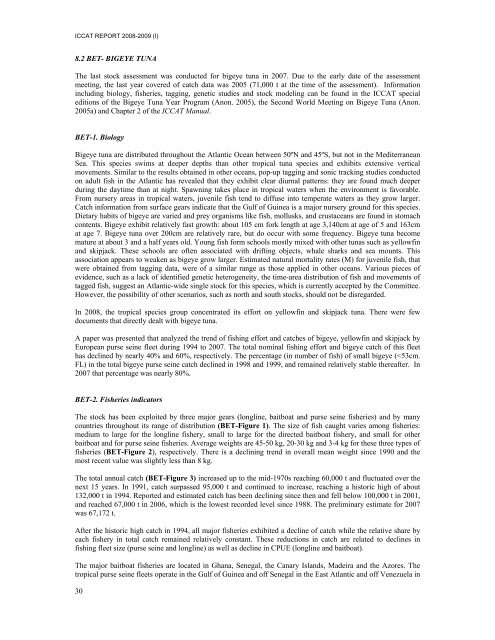REPORT OF THE STANDING COMMITTEE ON RESEARCH ... - Iccat
REPORT OF THE STANDING COMMITTEE ON RESEARCH ... - Iccat
REPORT OF THE STANDING COMMITTEE ON RESEARCH ... - Iccat
Create successful ePaper yourself
Turn your PDF publications into a flip-book with our unique Google optimized e-Paper software.
ICCAT <strong>REPORT</strong> 2008-2009 (I)8.2 BET- BIGEYE TUNAThe last stock assessment was conducted for bigeye tuna in 2007. Due to the early date of the assessmentmeeting, the last year covered of catch data was 2005 (71,000 t at the time of the assessment). Informationincluding biology, fisheries, tagging, genetic studies and stock modeling can be found in the ICCAT specialeditions of the Bigeye Tuna Year Program (Anon. 2005), the Second World Meeting on Bigeye Tuna (Anon.2005a) and Chapter 2 of the ICCAT Manual.BET-1. BiologyBigeye tuna are distributed throughout the Atlantic Ocean between 50ºN and 45ºS, but not in the MediterraneanSea. This species swims at deeper depths than other tropical tuna species and exhibits extensive verticalmovements. Similar to the results obtained in other oceans, pop-up tagging and sonic tracking studies conductedon adult fish in the Atlantic has revealed that they exhibit clear diurnal patterns: they are found much deeperduring the daytime than at night. Spawning takes place in tropical waters when the environment is favorable.From nursery areas in tropical waters, juvenile fish tend to diffuse into temperate waters as they grow larger.Catch information from surface gears indicate that the Gulf of Guinea is a major nursery ground for this species.Dietary habits of bigeye are varied and prey organisms like fish, mollusks, and crustaceans are found in stomachcontents. Bigeye exhibit relatively fast growth: about 105 cm fork length at age 3,140cm at age of 5 and 163cmat age 7. Bigeye tuna over 200cm are relatively rare, but do occur with some frequency. Bigeye tuna becomemature at about 3 and a half years old. Young fish form schools mostly mixed with other tunas such as yellowfinand skipjack. These schools are often associated with drifting objects, whale sharks and sea mounts. Thisassociation appears to weaken as bigeye grow larger. Estimated natural mortality rates (M) for juvenile fish, thatwere obtained from tagging data, were of a similar range as those applied in other oceans. Various pieces ofevidence, such as a lack of identified genetic heterogeneity, the time-area distribution of fish and movements oftagged fish, suggest an Atlantic-wide single stock for this species, which is currently accepted by the Committee.However, the possibility of other scenarios, such as north and south stocks, should not be disregarded.In 2008, the tropical species group concentrated its effort on yellowfin and skipjack tuna. There were fewdocuments that directly dealt with bigeye tuna.A paper was presented that analyzed the trend of fishing effort and catches of bigeye, yellowfin and skipjack byEuropean purse seine fleet during 1994 to 2007. The total nominal fishing effort and bigeye catch of this fleethas declined by nearly 40% and 60%, respectively. The percentage (in number of fish) of small bigeye (
















